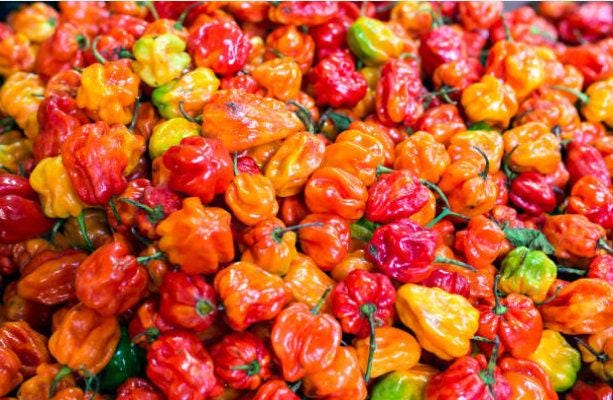Habanero chillies are a happy looking bunch. They have colorful skins that ripen from green to yellow and then orange to red as they mature. But as much as their looks are inviting, they are among the hottest chilli peppers commonly grown in the world. Incredibly fierce they have a rating of 200,000 to 350,000 on the Scoville scale.
Used in Mexican and Caribbean cuisine, they are also good for making chutneys and chilli sauces. The Habanero when dried and powdered has a unique apricot scent. They will grow happily outside over the summer in pots, or planted into the garden, but bring them in before the first frosts to prolong fruiting.
Though the greatest quantities of Habanero peppers are now grown in the Yucatan in Mexico, they once played an important part in the industry of "La Habana," or Havana, from which they receive their name. Habanero peppers spread so far so quickly that they also became called Chinese peppers, since some believed that was their place of origin. Habanero peppers are the hottest open pollinated pepper available.
The official heat scale for chillies is known as the Scoville scale, developed by Wilbur Scoville in 1912.To give you an idea of the range of heat in an habanero: a sweet pepper scores 0 on the scale, jalapeño and chipotle chillies score anything between 2,500 to 10,000 and habaneros score 200,000 to 300,000!
The Scotch bonnet is often compared to the habanero, as they are two varieties of the same species but have different pod types. Both the Scotch bonnet and the habanero have the characteristic thin, waxy flesh. They have similar heat level and flavour.
~ planting ~
Start indoors in March. The seed is slower to germinate (up to 3 weeks) and should be kept at 70-75°F. Use bottom heat of a Seedling Warmer heat mat to accelerate germination. Sow indoors ¼-½” deep. Keep soil as warm as possible. Seedling heating mats speed germination. Try to keep seedlings at 64-75°F in the day, and 61-64°F at night. Before they become root-bound, transplant them into 3″ pots. For greatest possible flower set, try to keep them for 4 weeks at night, about 55°F. Then transplant them into 6″ pots, bringing them into a warm room at night, about 70°F.
~ growing ~
Soil should have abundant phosphorus and calcium, so add lime and compost to the bed at least three weeks prior to transplanting. Mix ½ cup of complete organic fertilizer beneath each plant. Though peppers will tolerate dry soil, they will only make good growth if kept moist. Harden off before planting out in June, 30-60cm (12-24″) apart. Water in with kelp-based fertilizer. Using plastic mulch with a cloche can increase the temperature few degrees. Pinch back growing tips to encourage leaf production. this helps shade peppers and prevents sun-scald in hot summers.
~ harvesting ~
Harvest when peppers start to turn orange/red. When harvesting, take care to avoid touching the interior of any broken peppers, as the capsaicin is an extreme irritant, especially to the eyes. Wash hands thoroughly after harvesting, or wear gloves to harvest peppers. Harvesting hot peppers is basically a matter of personal preference. Generally, the longer the peppers mature on the vine, the hotter they will taste. Mature peppers, however, signal the plant to stop producing; if the peppers are picked when still at the green stage, the plant will go on producing. Always use a knife or scissors to remove peppers to prevent damage to the fragile stems.



















